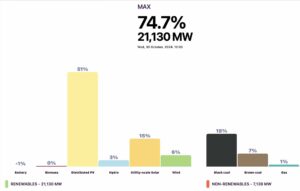New modelling has detailed how Australians are being left with an annual health bill of more than $2.4 billion due to the impacts of coal pollution, with leading environmental law experts claiming that a lack of pollution controls effectively amount to a ‘licence to harm’.
The new analysis has been published by Environmental Justice Australia and has assessed the impacts of coal pollution on health across three factors, which including premature deaths, low birth weight live births and additional days of asthma symptoms.
The modelling, completed by a team from the Actuaries Institute of Australia, assessed each of these factors against two metrics; the direct economic costs and the costs caused by the ‘burden of disease’.
The modelling drew upon peer reviewed research recently published by Greenpeace Australia that has estimated that coal pollution has been responsible for causing approximately 800 premature deaths, 14,500 asthma attacks and 850 babies to be born with low birthweight.
Across these factors, the modelling estimated the costs of coal pollution in Australia on human health at more than $2.4 billion each year, which is in addition to the costs that will be caused by coal emissions through the impacts of global warming.
Coal pollution affects a staggering proportion of the Australian community, with as many as 2.1 million Australians exposed to some form of toxic pollution produced by coal-fired power stations, which can contribute to heart disease, stroke, lung cancer, low birthweight babies, and Type 2 diabetes.
Environmental Justice Australia said that the report showed the extent to which Australia’s fleet of coal power stations escapes the costs of the health impacts caused by the pollution produced from the burning of coal.
“Deadly air pollution generated by Australia’s 22 ageing coal-burning power stations can no longer be ignored and our governments must urgently move to address the serious flaws in our regulatory system that have fuelled this public health crisis,” lawyer for Environmental Justice Australia, Bronya Lipski, said.
Lipski pointed to the fact that Australia’s fleet of coal-fired power stations bear none of the costs of the pollution that they are responsible for, and said that this lack regulation from governments effectively amounted to a ‘licence to harm’.
“We have a public health crisis generated by lack of pollution control on coal-fired power stations. No Australian state has any active strategy to reduce air pollution with policies and programs to ensure clean air. Australia’s coal-fired power stations are not even fitted with many of the basic pollution controls required in most other countries that can cut toxic pollutants by more than 85 per cent,” Lipski said.
“Instead, power stations in Australia are licenced to emit pollutant concentrations that dramatically exceed limits set by comparable countries. This amounts to our governments giving these coal-fired power stations a licence to harm our communities.”
University of Queensland economist John Quiggin said that the findings from the Actuaries Institute of Australia modelling showed that Australians were carrying a significant cost burden caused by coal pollution and that, in light of the current health challenges facing the world, governments should be moving to address coal pollution.
“The Actuaries Institute report confirms that Australians, rather than big polluters, are paying a hidden health cost,” Quiggin said. “The economic damage caused by coal far outweighs any benefits — which have, in any case, largely disappeared.
“As a possible recovery from the COVID-19 pandemic comes into sight, it’s time to place human health above the desire to maintain the economic status quo. Australia can and should get off coal by 2030, without harming workers employed in the industry. In doing so, we will be saving both lives and money.”
Environmental Justice Australia has called on state governments to introduce urgently needed regulatory measures, to address the impacts of pollution caused by coal-fired power stations.
“State governments must urgently crack down on air pollution and implement clean air strategies with measures to reduce pollution from coal-fired power stations to as close to zero as possible, set strong stack emission limits in line with international standards and require operators to install continuous stack monitoring and best practice pollution controls,” Lipski added.









